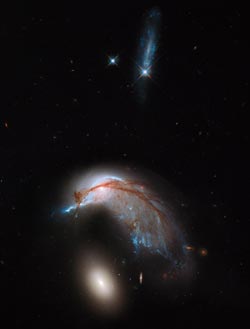Hubble spots galaxies in close encounter

Hubble image of Arp 142 <br>Image credit: NASA, ESA, and the Hubble Heritage Team (STScI/AURA)<br>
When two galaxies stray too close to each other they begin to interact, causing spectacular changes in both objects. In some cases the two can merge — but in others, they are ripped apart.
Just below the centre of this image is the blue, twisted form of galaxy NGC 2936, one of the two interacting galaxies that form Arp 142 in the constellation of Hydra. Nicknamed “the Penguin” or “the Porpoise” by amateur astronomers, NGC 2936 used to be a standard spiral galaxy before being torn apart by the gravity of its cosmic companion.
The remnants of its spiral structure can still be seen — the former galactic bulge now forms the “eye” of the penguin, around which it is still possible to see where the galaxy's pinwheeling arms once were. These disrupted arms now shape the cosmic bird's “body” as bright streaks of blue and red across the image. These streaks arch down towards NGC 2936's nearby companion, the elliptical galaxy NGC 2937, visible here as a bright white oval. The pair show an uncanny resemblance to a penguin safeguarding its egg.
The effects of gravitational interaction between galaxies can be devastating. The Arp 142 pair are close enough together to interact violently, exchanging matter and causing havoc.
In the upper part of the image are two bright stars, both of which lie in the foreground of the Arp 142 pair. One of these is surrounded by a trail of sparkling blue material, which is actually another galaxy. This galaxy is thought to be too far away to play a role in the interaction — the same is true of the galaxies peppered around the body of NGC 2936. In the background are the blue and red elongated shapes of many other galaxies, which lie at vast distances from us — but which can all be seen by the sharp eye of Hubble.
This pair of galaxies is named after the American astronomer Halton Arp, the creator of the Atlas of Peculiar Galaxies, a catalogue of weirdly-shaped galaxies that was originally published in 1966. Arp compiled the catalogue in a bid to understand how galaxies evolved and changed shape over time, something he felt to be poorly understood. He chose his targets based on their strange appearances, but astronomers later realised that many of the objects in Arp's catalogue were in fact interacting and merging galaxies [1].
This image is a combination of visible and infrared light, created from data gathered by the NASA/ESA Hubble Space Telescope Wide Field Planetary Camera 3 (WFC3).
Notes
[1] The birth and evolution of various sets of merging galaxies was the subject of the book Cosmic Collisions – The Hubble Atlas of Merging Galaxies, produced by Springer and the European Southern Observatory. The book is illustrated with a range of stunning Hubble Space Telescope images.
More information
The Hubble Space Telescope is a project of international cooperation between ESA and NASA.
Image credit: NASA, ESA, and the Hubble Heritage Team (STScI/AURA)
Contacts
Nicky Guttridge
ESA/Hubble
Garching, Germany
Tel: +49-89-3200-6855
Email: nguttrid@partner.eso.org
Media Contact
All latest news from the category: Physics and Astronomy
This area deals with the fundamental laws and building blocks of nature and how they interact, the properties and the behavior of matter, and research into space and time and their structures.
innovations-report provides in-depth reports and articles on subjects such as astrophysics, laser technologies, nuclear, quantum, particle and solid-state physics, nanotechnologies, planetary research and findings (Mars, Venus) and developments related to the Hubble Telescope.
Newest articles

Sea slugs inspire highly stretchable biomedical sensor
USC Viterbi School of Engineering researcher Hangbo Zhao presents findings on highly stretchable and customizable microneedles for application in fields including neuroscience, tissue engineering, and wearable bioelectronics. The revolution in…

Twisting and binding matter waves with photons in a cavity
Precisely measuring the energy states of individual atoms has been a historical challenge for physicists due to atomic recoil. When an atom interacts with a photon, the atom “recoils” in…

Nanotubes, nanoparticles, and antibodies detect tiny amounts of fentanyl
New sensor is six orders of magnitude more sensitive than the next best thing. A research team at Pitt led by Alexander Star, a chemistry professor in the Kenneth P. Dietrich…





















